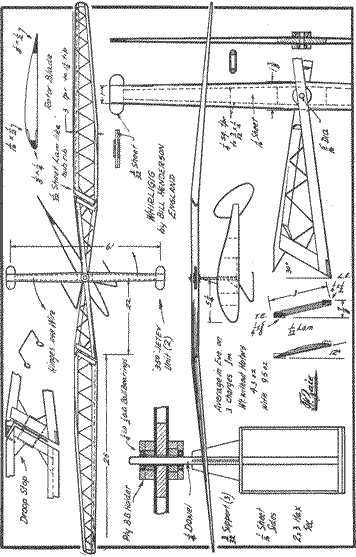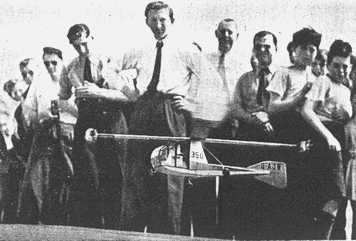|
Bill Henderson on 'Jeticopter Design'
Frank Zaic published the following design advice from Bill in his 1953 Yearbook:
Opinion varies as to the various sizes and weights etc. that are most suitable for each size of motor but the table below gives a general idea of the majority opinion.
| ENGINE |
50 |
100 |
200 |
300 |
| Rotor Diameter |
24 in. |
36 in. |
50 in. |
72 in. |
| Wt.without motors |
0.56 oz. |
1.5oz. |
2.75 oz. |
5 oz. |
| Wt. with motors |
1.0 oz. |
2.75 oz. |
5.0 oz. |
9.5 oz. |
| Area of one blade |
9 in.2 |
21 in.2 |
32 in.2 |
64 in.2 |
| Span Loading |
0.5 oz/ft |
0.92 oz/ft |
1.2 oz/ft |
1.9oz/ft |
It is obvious with this form of modelling as with every other, that power/weight ratio is important and with fixed power motors, weight must be cut down as much as possible to get a better contest performance.
The Span Loading is taken so it is proportional to the disc loading and is in figures more easily comprehended. The Rotor Center Section is usually about 28-35% of the Rotor Diameter. The Pitch Angle varies from model to model but generally use 15° on "5O" and "100" models, and 12° on "200" to "350" models. The "delta 3" (full-size parlance for the system of skew hinge system for producing auto-rotation angle) can vary between 30° and 35°.
The rotor centre section can be made from ply with hinges mounted in blocks at ends at approximate pitch angle. This is easier than building it up but it is heavier.
Should anyone be a stickler for helical pitch they can build the outer rotor blades on a pitch angle jig, but generally fiat ones set at the approximate angle by the hinges on the centre section will be quite effective.
These models will ascend fairly quickly and should descend on auto-rotation much more slowly, in fact in good thermal conditions they should be able to soar slightly and thus greatly enhance their performance.
Ball races are not necessary in the head bearings but are strongly recommended on "200" and "35O" models, they being much more friction free than an ordinary journal bearing.
The hinges used are universal on all sizes of jeticopters and so far no other satisfactory one has been thought of, but some improvements could possibly be made to lock hinge wire in place and yet allow it to be taken out for ease of transportation.

|
 |
'Whirligig' for twin Jetex 350s by Bill Henderson
(An enlargement of this plan will be available when this material is transferred to the main public area of the website)

|
The following "Thoughts on the helicopter" by Parnell Schoenky come from Frank Zaic's Yearbook of 1955/56. Note the reference (in the sixth paragraph) to "the Henderson Whirligig".
THOUGHTS ON THE HELICOPTER
by Parnell Schoenky, Kirkwood, Mo.
There must be quite a few creative modelers still with us, for interest in quality events such as R/C, Clipper Cargo, Wakefield and Navy Carrier continues to grow. There is evidence that some of these modelers are becoming intrigued by the helicopter event, now that the Hiller Competition rules have given it direction and new life. The lack of basic rotary wing know-how is naturally a deterrent to many modelers, as is the scarcity of meets offering the helicopter event. I would like to offer a few hints on the first count; the contest opportunities will come when more of us get out of the easy kit habit and do a bit more experimenting on our own.
What can you expect of a we]]-made helicopter, built to one of the current designs? Right now, climb and duration are plenty good - but stability and control leave much to be desired. There is plenty of challenge here, and that's what makes it so interesting. The creative modeler who isn't afraid of work can make some genuine contributions to our knowledge of model 'copter design.
Most of the gas-powered helicopters flown at the past three Nationals have utilized the Clough feathering rotor system, and employ either 3 or 4 blades in the main rotor. These models will make beautiful vertical flights in calm evening air, provided that their blades are freely pivoted and have identical hinge axes at the proper chord point, and further provided that rotor inertia is sufficiently low to permit rotor RPM of t25 to 175 to be obtained from low-torque glo engines. Try adding a pinch of clay for nose ballast; the conventional feathering-rotor 'copter will ease forward-probably start to circle, as propwash takes effect on the fuselage. The contest judges will never see that gentle forward motion on a typical breezy contest day, so let us add more clay. Up she goes . . . and forward . . . nose eases down farther - too much! Almost every such model will nosedive or spiral dive when ballasted for a useful degree of horizontal movement. Now you know how Langley and Lilenthal. Wilbur and Orville used to feel. It's back to the shop for pliers and pencil...there must he a way to make model helicopters with far better longitudinal stability than the feathering rotor type. Suppose the problem is simply to make a vertical flight, but the wind is
fresh and gusty. Should turbulent air tip an underpowered model or one with an overlarge fuselage and fin, you've had it. Either the model slips rapidly, goes into a dive as though noseheavy, or inverts completely and falls like a dead duck. What's the answer? Excess horsepower helps, as do high-speed rotors with their greater gyroscopic stability effect. Get off to a good start by keeping your mind on these painfully simple features: a) 11ght weight, b) ample power, c) smooth-functioning, carefully balanced rotating and pivoting parts. Through neglect of such elementary requirements, half of all helicopters built are glued to the ground-and half of those that do get aloft are prone to wobble uncertainly and work themselves into a spiral dive.
If your model falls into the latter class, it's time to do a little thinking and a lot of experimenting. Consider the fuselage; it is working in a strong slipstream which may impinge on the top and sides in such manner as to destabilize the model. Recheck mast alignment. Move the c.g. farther forward, then aft, so that you know for sure what its effects are. Follow with more drastic steps: rip off your original fuselage and replace it with a cleaner version. Consider various rotor changes, such as a change in blade pivot point, shorter and heavier tip weights, stiffer or more flexible blades, or even a different small prop. The main thing is that you experiment until you find out just what YOUR model needs to make it fly right - no one can lay down rules for trimming models when people almost invariably modify kits or published plans, or come up with original designs whose features (and construction) vary all over the map. Some of my experimental models have been flown hundreds of times, and even when they crashed they were yielding useful information - it is almost as helpful to know what won't work as what will.
For jet-powered helicopters, the combination of Jetex power units with the British layout developed by Boreham can hardly be beat. Should you want to start with a thoroughly dependable type of whirlybird and don't mind the expense and involved loading procedures common to Jetex, get a pair of the "150" Jetmasters and make the JH-2 (1954-55 AEROMODELLER ANNUAL), or, scale down the Henderson Whirligig (1953 ZAIC YEARBOOK) or the JH-3 (AUG. 55 MAN)) to about 40 in. rotor diameter. No fancy metal parts are required, but do make the rotor blade supports and engine straps sturdy. These skewed-hinge (pitch-cone coupled, that is) helicopters climb well. are highly stable, and autorotate so well that they have been known to pick up risers and soar a bit. They fly well in breezy weather, once they get started, but don't do much better than the feathering rotor in horizontal flight.
So far rubber helicopters designed for the Hiller Competition are too few in number for any design trends too have emerged. Don't neglect this type of power, however, for its great simplicity and cheapness allow one to concentrate on the more important stability aspects of the design. One of the best features of the Hiller event is emphasis on stability and control rather than on duration alone, making work with rubber and Jetex power as rewarding as that with the glo and diesel engines.
THE WORK AHEAD. Most of all, we need to develop new rotor and control systems that will enable our mode] 'copters to achieve highly stable longitudinal flight. The designers who comes up with a good solution to this problem will have the Hiller Trophy nailed down for a few years. Efficiency in hovering flight, in climb and in autorotative descent offers additional interesting problems, though none either so difficult or so rewarding of solution as those associated with stability. After we have mastered the problems of translational flight and are able to put our models through typical 'copter maneuvers, payloads, and other measures of efficiency in order to sort out the winners in this event. There is a great deal of room for originality in type and applications of powerplants for model helicopters, such as pressure- jet rotors, enclosed engines. Piasecki layouts, and of course the kinesthetically controlled "flying platform' type of ducted fan helicopter. The key to getting more modelers active in helicopters is to step up the exchange of information on design and adjustments. Along with your experiments, read all you can find about 'copters in back issues of the U.S. and British model mags. Should your problems persist after dozens of test hops, sketch up your model, describe its flight characteristics in detail, and fire off a letter to the nearest model helicopter "expert".
Parnell Schoenky
125 East Maple Avenue
Kirkwood 22, Missouril
|
|
Phil Smith on Jetex Helicopters
The following is extracted from an article on "Jetex Powered Flying Scale Models" in Aeromodeller Annual by Phil Smith,
Chief Designer to Model Aircraft (Bournemouth) Ltd.,
Makers of "Veron" Kits.
The fitting of Jetex as propulsive units to the rotors of model helicopters, is a "natural". Much has already been written about this type of model, but it must he acknowledged that this mode of power is far superior to rubber motors for turning the rotors. Rubber motors require such a long length to give a suitable duration, that the resultant fuselage (to wit—stick helicopters) completely rules out scale dimensions. Some modern helicopters have small ram-jets upon the rotor tips, but although it is known that Jetex units so placed can rarely be synchronised and balanced, this has quite easily been overcome by fitting the units to a transverse beam of ply or similar material as in the Jeticopter designs. This, coupled with a simple system of angular hinge lines for auto-rotation of the blades, means that model helicopter design has now assumed more normal proportions to scale and near scale. At this year's Northern Heights Gala Day, second place in the helicopter trophy was taken with a twin Jetex 350 powered helicopter, which was as near scale as one could wish. Its flight of 2 mins. 51 secs. means an autorotational glide of some 2 mins. 16 secs., which is better than most scale rubber jobs.

|
 |
This photograph, which accompanied the article, was captioned:
"The fascinating
twin Jetex 350 Helicopter
flown so successfully by
Joe Mansour, partner in
Wilmot Mansour & Co.
Ltd., manufacturers of the
Jetex motor units."

|

|
|
|

